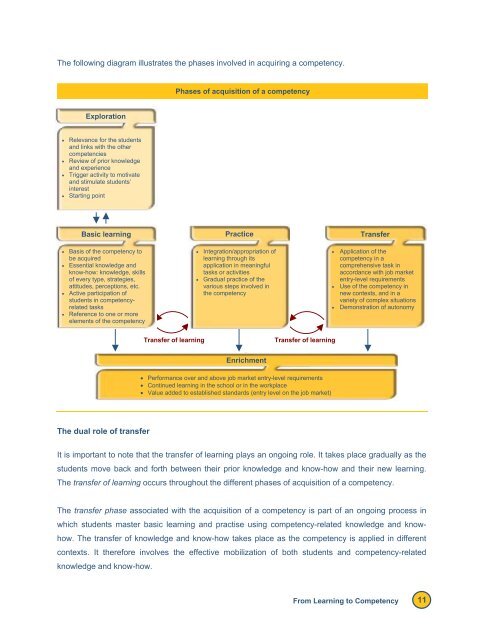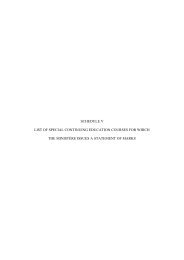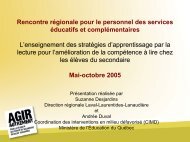Reference Framework for Planning Learning and Evaluation Activities
Reference Framework for Planning Learning and Evaluation Activities
Reference Framework for Planning Learning and Evaluation Activities
You also want an ePaper? Increase the reach of your titles
YUMPU automatically turns print PDFs into web optimized ePapers that Google loves.
The following diagram illustrates the phases involved in acquiring a competency.<br />
Phases of acquisition of a competency<br />
Exploration<br />
• Relevance <strong>for</strong> the students<br />
<strong>and</strong> links with the other<br />
competencies<br />
• Review of prior knowledge<br />
<strong>and</strong> experience<br />
• Trigger activity to motivate<br />
<strong>and</strong> stimulate students’<br />
interest<br />
• Starting point<br />
Basic learning<br />
• Basis of the competency to<br />
be acquired<br />
• Essential knowledge <strong>and</strong><br />
know-how: knowledge, skills<br />
of every type, strategies,<br />
attitudes, perceptions, etc.<br />
• Active participation of<br />
students in competencyrelated<br />
tasks<br />
• <strong>Reference</strong> to one or more<br />
elements of the competency<br />
Practice<br />
• Integration/appropriation of<br />
learning through its<br />
application in meaningful<br />
tasks or activities<br />
• Gradual practice of the<br />
various steps involved in<br />
the competency<br />
Transfer<br />
• Application of the<br />
competency in a<br />
comprehensive task in<br />
accordance with job market<br />
entry-level requirements<br />
• Use of the competency in<br />
new contexts, <strong>and</strong> in a<br />
variety of complex situations<br />
• Demonstration of autonomy<br />
Transfer of learning<br />
Transfer of learning<br />
Enrichment<br />
• Per<strong>for</strong>mance over <strong>and</strong> above job market entry-level requirements<br />
• Continued learning in the school or in the workplace<br />
• Value added to established st<strong>and</strong>ards (entry level on the job market)<br />
The dual role of transfer<br />
It is important to note that the transfer of learning plays an ongoing role. It takes place gradually as the<br />
students move back <strong>and</strong> <strong>for</strong>th between their prior knowledge <strong>and</strong> know-how <strong>and</strong> their new learning.<br />
The transfer of learning occurs throughout the different phases of acquisition of a competency.<br />
The transfer phase associated with the acquisition of a competency is part of an ongoing process in<br />
which students master basic learning <strong>and</strong> practise using competency-related knowledge <strong>and</strong> knowhow.<br />
The transfer of knowledge <strong>and</strong> know-how takes place as the competency is applied in different<br />
contexts. It there<strong>for</strong>e involves the effective mobilization of both students <strong>and</strong> competency-related<br />
knowledge <strong>and</strong> know-how.<br />
From <strong>Learning</strong> to Competency 11




